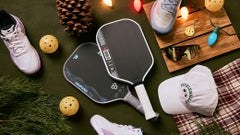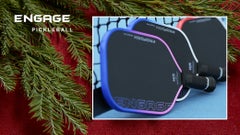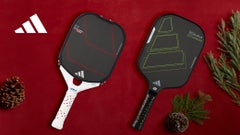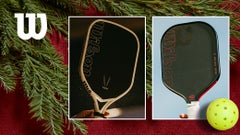How Paddle Weight Affects Performance
When you first pick up a pickleball paddle, one of the first things you’ll notice is whether it feels light or heavy in your hand. Although it’s not the only factor, weight is a primary aspect of how your paddle performs. We explain the pros and cons of lighter and heavier paddles to help you find the ideal paddle weight for you.
Every paddle delivers a combination of agility and stability. Finding the paddle with the proper ratio of those traits is key to choosing a paddle weight that is ideal for you.
We recommend playing with the heaviest paddle you can handle, not the lightest. Part of the reason we recommend this because if a paddle is too light, it can cause discomfort. Lighter paddles have less material and do not disperse vibration created at contact of the ball as well as heavier paddles. Your paddle should be heavy enough to be comfortable and stable but still feel maneuverable for your playing style. Of course, this varies from player to player.
Players who base much of their game around net play and like a paddle that feels easy to move around, a lighter paddle is the way to go. For those who like to hit with a lot of power from the baseline, a heavier paddle will be a better fit. That said, the difference in weight between what a player will perceive as either being a heavy or light paddle can be as little as 5 grams.
Defining Light and Heavy
When you’re shopping for paddles you’re likely to see them described as either lightweight, midweight or heavy. Although what feels light to one player might be heavy to another, typically paddles that weigh 7.5 ounces or less are categorized as lightweight. A mid-range range of paddle weight is between 7.6 and 8.2 ounces. Paddle weights north of 8.2 ounces are considered on the heavier side.
Pros and Cons of Lighter Paddles
Lighter paddles are ideal for:
- A speedy and agile feel through the air
- Getting the paddle into position on time
- Precision and predictability near the kitchen
- Young kids just starting
- Older, senior players just starting.
Lighter paddles can feel unstable and are less than ideal when:
- Ball contact is off center
- Conditions are windy
- Ball pace is excessive
- Generating pace
- Changing direction of the ball.
Pros and Cons of Heavier Paddles
Heavier paddles are better for:
- Overall stability
- Playing in the wind
- Vibration dampening
- Changing direction of the ball
- Absorbing pace
- Easier power from the baseline (serves, returns and groundstrokes).
Potential pitfalls of heavier paddles include:
- The paddle can be harder to maneuver, especially in fast exchanges.
- If it’s far too heavy, you could experience discomfort.
In Conclusion
Another way to describe an ideal paddle weight is to say that it is light enough for all day play, yet heavy enough to remain stable against heavier struck shots, off-center ball contact and in windy conditions. Ultimately, you want your paddle to beat the ball and not the other way around.
It always feels great when you find a paddle you like within the first few minutes of play. However, we recommend not immediatley making up your mind. Try a new paddle over the period of time you most often play and with those you most often encounter at the courts. That way you can determine if the paddle complements your approach to the game is that it feels the same in the last 15 minutes of play the same way it did in the first 15 minutes and everything in between.









